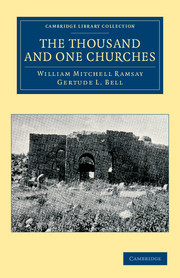Description
The Thousand and One Churches
Cambridge Library Collection - Travel, Middle East and Asia Minor Series
Authors: Ramsay William Mitchell, Bell Gertude L.
First published in 1909, this archaeological guide establishes the chronology of the Byzantine churches of Bin-Bir-Kilisse in Turkey.
Language: English
Approximative price 54.78 €
In Print (Delivery period: 14 days).
Add to cart
Publication date: 01-2012
Support: Print on demand
Support: Print on demand
Description
/li>Contents
/li>
Written by two of the most eminent Anatolian experts of the day, this book on church history and architecture in Turkey was first published in 1909. Sir William Mitchell Ramsay (1851?1939), Scottish classical scholar and archaeologist, and Gertrude Bell (1868?1926), traveller, archaeologist and diplomatist, joined forces for an expedition investigating the Hittite and Byzantine site of Bin-Bir-Kilisse in Turkey in 1907. Bell was successful in establishing the chronology of Byzantine churches, and her findings constitute the middle two parts of the book, on buildings and ecclesiastical architecture. Ramsay contributed the first and last parts, on the historical and geographical details of the churches and an account of other notable monuments in the region. Ramsay was knighted in 1906 and both scholars were honoured by the Royal Geographical Society. In 1913 Bell became one of the first women to be elected a Fellow of the Society.
Preface; Part I. Situation and History: 1. The Black Mountains; 2. Maden Sheher; 3. The Lower and the Upper City; 4. Deghile; 5. The churches; 6. Origin of the name Maden Sheher; 7. The mountain was holy; 8. Analogy of Mount Sinai; 9. Style and date of the churches; 10. Date and character of the churches; 11. The power of the Church; 12. Churches as memorials of the dead; 13. The water supply; 14. Constructions for storing water; 15. The Turks in Maden Sheher; Part II. The Buildings: 1. Churches Nos. 1–29, at Maden Sheher; 2. Churches Nos. 30–48, at Deghile; 3. Mausoleums; 4. Mahaletch; 5. Asamadi; 6. Maden Dagh; 7. Kizil Dagh and Tehet Dagh; 8. Kaya Sarinteh; 9. Fortresses (Bash Dagh, etc.); Part III. Ecclesiastical Architecture: 1. The Basilica; 2. Churches with a single chamber; 3. Cruciform churches; 4. The octagon; 5. The vault; 6. Brick and stone architecture; 7. Monasteries; 8. Mouldings and ornamental details; 9. Fortresses; Part IV. Other Monuments of the Kara Dagh: 1. Hittite; 2. Milestones and boundary-stones; 3. Sarcophagi; 4. Inscriptions of the churches; 5. Other inscriptions; 6. Sculpture; 7. Wine-presses; Concluding chapter: the ancient name of Maden Sheher; Index.
© 2024 LAVOISIER S.A.S.
These books may interest you

Amurath to Amurath 47.09 €



